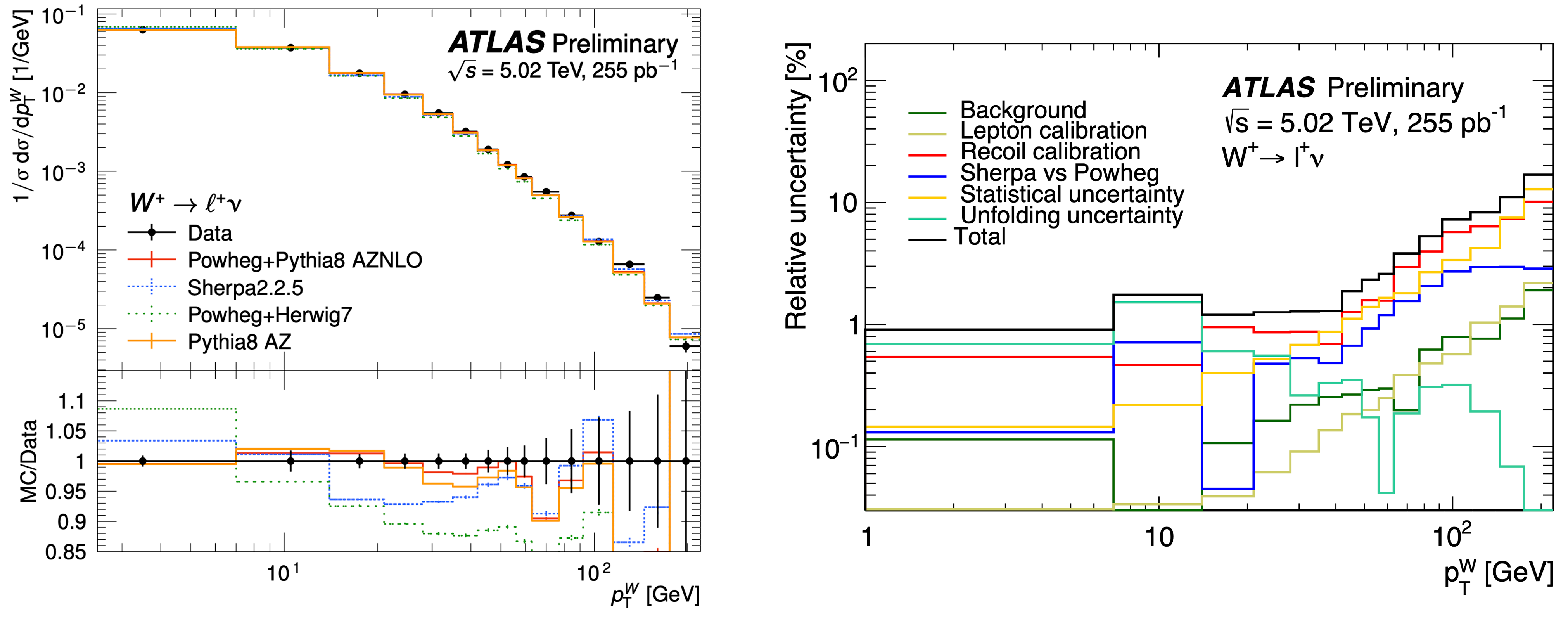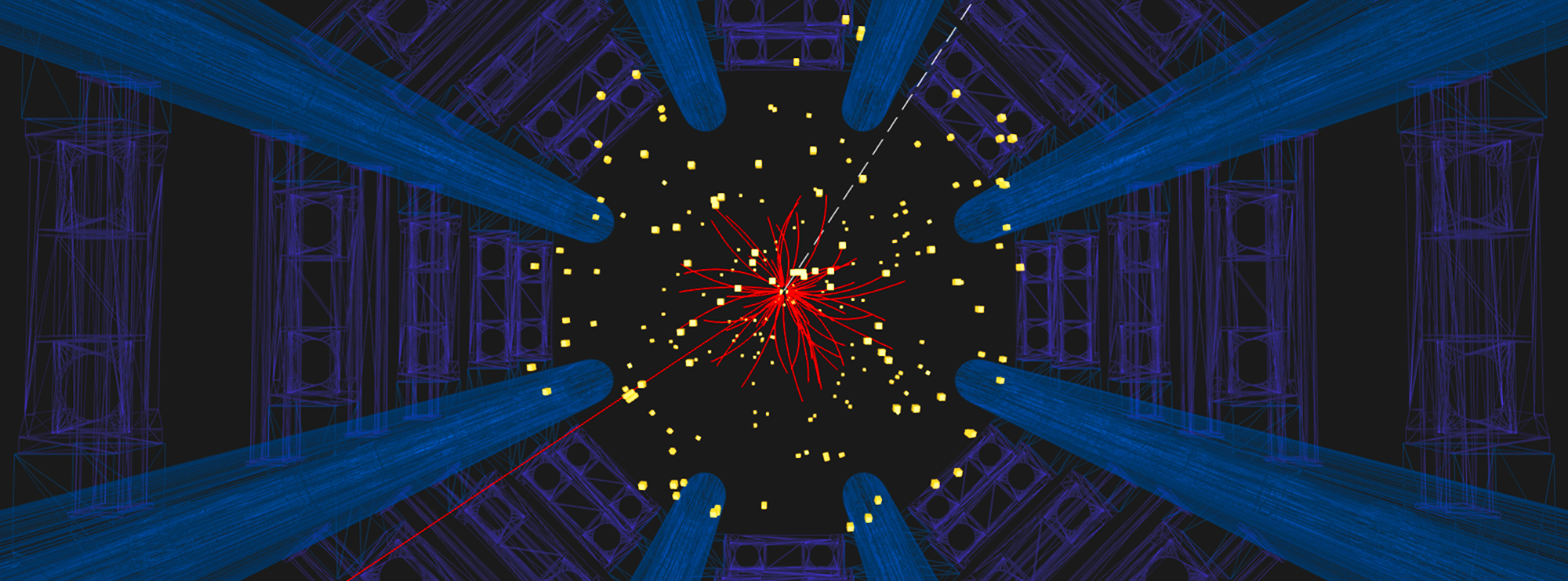New high-precision measurements of W and Z boson properties
25 May 2023 | By
Ever since their discovery at CERN in the 1980s, the W± and Z bosons have been the subject of extensive research. As the carriers of the weak force, measurements of their properties are crucial for understanding elementary interactions. For instance, measurements of the W-boson mass are a critical test of the validity of the Standard Model of particle physics. The weak mixing angle, which gives the relationship between the W± and Z bosons masses, is another such essential input to consistency tests.
At the 2023 LHCP conference, physicists from the ATLAS Experiment presented precise new measurements of the W± and Z boson transverse momentum (pT) distributions at two centre-of-mass energies: 13 TeV and, for the first time, 5.02 TeV. These results give unprecedented information on these pT shape spectra, providing crucial input for other studies of these bosons. For example, when determining the W-boson mass, incorporating a direct measurement of the W-boson transverse momentum will reduce the uncertainty on underlying assumptions about how the W boson is produced. These new results also allowed researchers to study Quantum Chromodynamics (QCD, the theory that describes the interactions that bind quarks together) from the small transverse-momentum range up to large boosts of the bosons in the transverse plane.
Precise measurements of the W and Z boson transverse momentum are crucial input for several key studies of these bosons.
New approach for new precision

While Z bosons can be well measured by the ATLAS detector, W± bosons are much more challenging. Unlike Z bosons, which decay into detectable lepton pairs, for these measurements researchers study W± bosons which decay into one charged lepton (either an electron or a muon) and a neutrino, a particle which cannot be measured directly by ATLAS.
Thus, ATLAS physicists needed a unique approach to achieve a precise measurement of the W-boson transverse momentum. This approach involved special experimental conditions during the data-taking step, where ATLAS operated with far fewer proton-proton collisions occurring simultaneously (low-pileup conditions). As a result, physicists were able to accurately measure the final states of W± bosons in a ‘clean’ experimental environment.
To reconstruct the W± boson’s momentum, physicists studied the detectable system of particles recoiling against it. This system is mostly composed of hadrons (the ‘hadronic recoil’). They did so using a novel technique involving Particle Flow Objects – algorithms that reconstruct the nature and kinematic properties of the particles – which reached their best resolution thanks to the low-pileup conditions. The hadronic recoil was calibrated with sub-percent-level precision, enabling researchers to study effects stemming from the collision activity with a very high degree of complexity. This, in turn, facilitated the correction of the mean, width and tails of the hadronic recoil distributions in simulations. Since the Z-boson transverse momentum can be measured either through its decay to a dilepton pair or through the hadronic recoil, it provided an important cross-check to thoroughly validate the method and calibrations used for the W± boson.

Results across the spectra
Six individual spectra, one for each particle at both centre-of-mass energies, were obtained. As an example, the figures above show the measured spectrum for the W+ at 5.02 TeV compared with theory predictions. These measurements reach a precision of 1-2% in the peak of the distribution – a marked improvement over previous ATLAS results. Researchers also compared the 13 TeV and 5.02 TeV spectra; these will also be a useful input to theoretical QCD predictions. In addition, physicists were able to determine the total cross sections for the W± and Z bosons. This measurement was substantially improved by ATLAS' recent precise luminosity measurement, resulting in an increased precision of the cross-sections by a factor of two or more.
This ensemble of results is important input for the theory effort within the LHC Physics Centre at CERN, helping theorists and experimentalists to better understand QCD predictions and setting the path for future W-boson-mass measurements by the ATLAS Collaboration.
Explore the interactive event display
Learn more
- Precise measurements of W and Z transverse momentum spectra with the ATLAS detector at 5.02 TeV and 13 TeV (ATLAS-CONF-2023-028)
- Measurement of the transverse momentum distribution of W bosons in proton–proton collisions at 7 TeV with the ATLAS detector (Phys. Rev. D 85, 012005, arXiv: 1108.6308, see figures)
- Measurement of W± and Z– boson production cross sections in proton–proton collisions at 13 TeV with the ATLAS detector (Phys. Lett. B 759 (2016) 601, arXiv: 1603.09222, see figures)
- LHCP 2023 presentation by Fabrice Balli: W/Z precision and differential measurements
- LHCP 2023 presentation by Sarah Demers: ATLAS status and overview
- New ATLAS result weighs in on the W boson, ATLAS Physics Briefing, March 2023
- Summary of new ATLAS results from LHCP 2023, ATLAS News, May 2023




